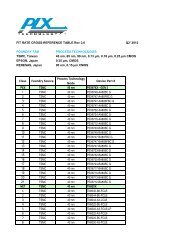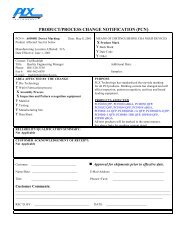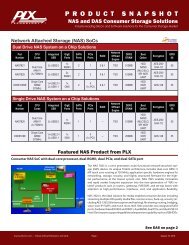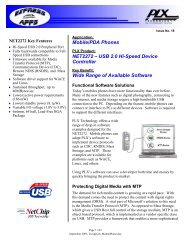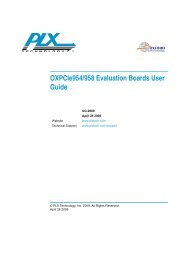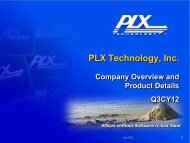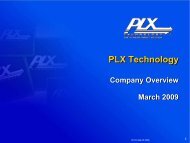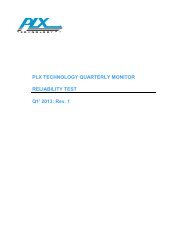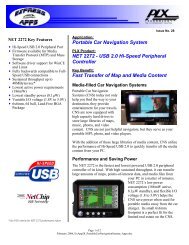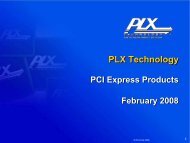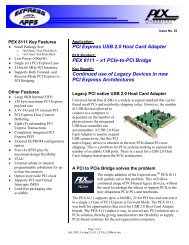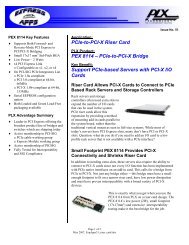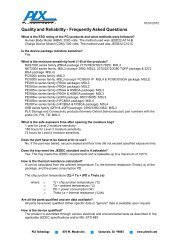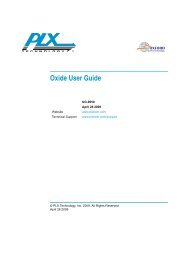the 2009 Annual Report (pdf) - PLX Technology
the 2009 Annual Report (pdf) - PLX Technology
the 2009 Annual Report (pdf) - PLX Technology
You also want an ePaper? Increase the reach of your titles
YUMPU automatically turns print PDFs into web optimized ePapers that Google loves.
Overview<br />
<strong>PLX</strong> was founded in 1986, and between 1994 and 2002 we focused on development of I/O interface<br />
semiconductors and related software and development tools that are used in systems incorporating <strong>the</strong> PCI standard.<br />
In 1994 and 1995, a significant portion of our revenues were derived from <strong>the</strong> sale of semiconductor devices that<br />
perform similar functions as our current products, except <strong>the</strong>y were based on a variety of industry standards. Our<br />
revenues between 1996 and 2007 were derived predominantly from <strong>the</strong> sale of semiconductor devices based on <strong>the</strong><br />
PCI standard to a large number of customers in a variety of applications including servers, networking and<br />
telecommunications, enterprise storage, imaging, industrial and o<strong>the</strong>r embedded applications as well as in related<br />
adapter cards. In 2002, we shifted <strong>the</strong> majority of our development efforts to PCI Express. In September 2004, we<br />
began shipping products based on <strong>the</strong> PCI Express standard for next-generation systems. Between 2004 and 2007, an<br />
industry-wide adoption of <strong>the</strong> PCI Express standard took place. PCI Express went from being one of many new<br />
protocols in <strong>the</strong> market to becoming <strong>the</strong> interconnect of choice and a basic building block of systems. Being a market<br />
leader in PCI Express, our line of PCI Express switches and bridges followed suit and also gained a lot of traction in<br />
<strong>the</strong> market. PCI Express was so well accepted that a follow-on was called for. In December of 2006, PCI Express Rev<br />
2.0 (commonly referred to as “PCIe Gen 2”) was released. The Gen 2 protocol doubled <strong>the</strong> bandwidth supported by<br />
PCI Express Gen 1 (from 2.5 Gigabits per second to 5.0 Gigabits per second) and incorporated a number of o<strong>the</strong>r<br />
protocol enhancements. In September 2007, we announced <strong>the</strong> addition of <strong>the</strong> Gen 2 switches to our PCI Express<br />
product family and began shipping in January 2008. We are in development of Gen 3 PCI Express supporting 8.0<br />
Gigabits per second.<br />
We utilize a “fabless” semiconductor business model whereby we purchase wafers and packaged and tested<br />
semiconductor devices from independent manufacturing foundries. This approach allows us to focus on defining,<br />
developing, and marketing our products and eliminates <strong>the</strong> need for us to invest large amounts of capital in<br />
manufacturing facilities and work-in-process inventory.<br />
We rely on a combination of direct sales personnel and distributors and manufacturers’ representatives throughout<br />
<strong>the</strong> world to sell a significant portion of our products. We pay manufacturers’ representatives a commission on sales<br />
while we sell products to distributors at a discount from <strong>the</strong> selling price.<br />
Our gross margins have fluctuated in <strong>the</strong> past and are expected to fluctuate in <strong>the</strong> future due to changes in product<br />
and customer mix, provisions and recoveries of excess or obsolete inventory, <strong>the</strong> position of our products in <strong>the</strong>ir<br />
respective life cycles, and specific product manufacturing costs.<br />
The time period between initial customer evaluation and design completion can range from six to twelve months<br />
or more. Fur<strong>the</strong>rmore, <strong>the</strong>re is typically an additional six to twelve month or greater period after design completion<br />
before a customer requests volume production of our products. Due to <strong>the</strong> variability and length of <strong>the</strong>se design<br />
cycles and variable demand from customers, we may experience significant fluctuations in new orders from month to<br />
month. In addition, we typically make inventory purchases prior to receiving customer orders. Consequently, if<br />
anticipated sales and shipments in any quarter do not occur when expected, expenses and inventory levels could be<br />
disproportionately high, and our results for that quarter and potentially future quarters would be materially and<br />
adversely affected.<br />
Our long-term success will depend on our ability to introduce new products. While new products typically<br />
generate little or no revenues during <strong>the</strong> first twelve months following <strong>the</strong>ir introduction, our revenues in subsequent<br />
periods depend upon <strong>the</strong>se new products. Due to <strong>the</strong> lengthy sales cycle and additional time before our customers<br />
request volume production, significant revenues from our new products typically occur twelve to twenty-four months<br />
after product introduction. As a result, revenues from newly introduced products have, in <strong>the</strong> past, produced a small<br />
percentage of our total revenues in <strong>the</strong> year <strong>the</strong> product was introduced. See “Item 1A, Risk Factors - Certain Factors<br />
That May Affect Future Operating Results -- Our Lengthy Sales Cycle Can Result in Uncertainty and Delays with<br />
Regard to Our Expected Revenues” in this Form 10-K.<br />
On December 15, 2008 we signed a definitive agreement to acquire all of <strong>the</strong> outstanding shares of capital stock<br />
of Oxford, a privately held fabless provider of industry-leading silicon and software for <strong>the</strong> consumer and small<br />
office/home office (SOHO) storage markets. The acquisition closed on January 2, <strong>2009</strong>. Additional information<br />
about <strong>the</strong> acquisition is set forth in Note 7 to <strong>the</strong> consolidated financial statements.<br />
23




